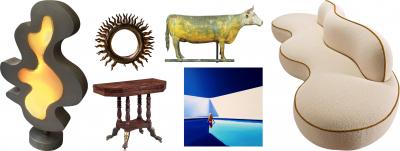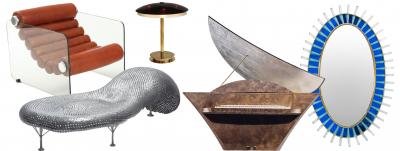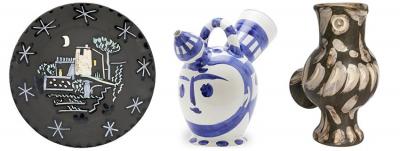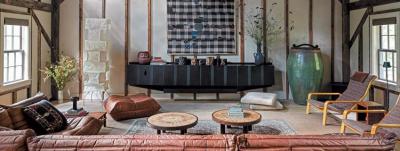Oxbow Furniture: Identifying The Form's Date Range
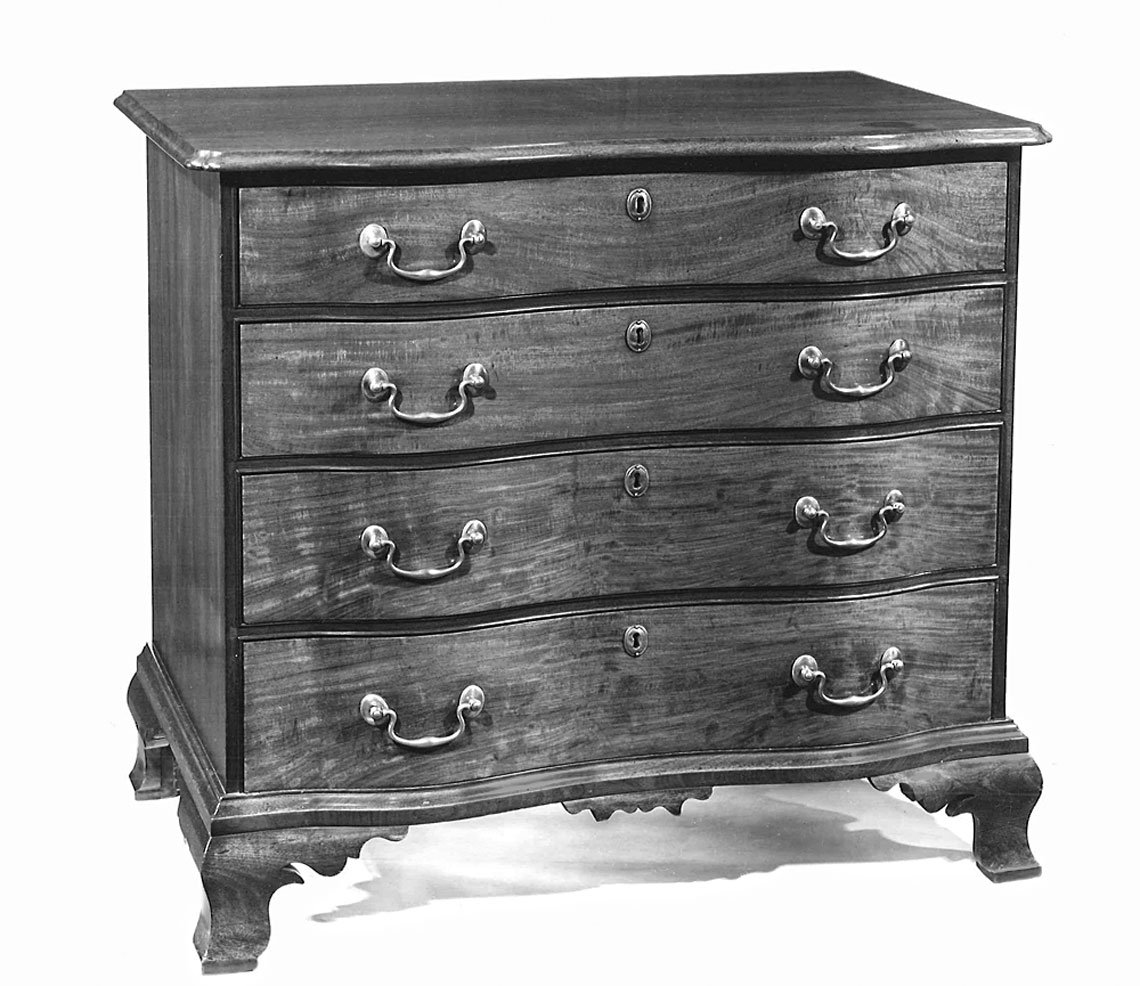 |  | |
| Fig. 1: Chest of drawers by John Chipman (1746-1819), Salem, Mass., 1794. Israel Sack advertisement in Antiques, November 1988. Courtesy Israel Sack, Inc. Archives, Yale University Art Gallery. | Fig. 2: Slant-lid desk, Samuel Stone and Giles Alexander (in partnership 1792–1796), Boston, Mass. Courtesy of Bernard and S. Dean Levy, Inc. |
F
urniture historians frequently date oxbow case furniture to the 1760s and 1770s; historical evidence, however, indicates otherwise. These case pieces—desks and chests of various kinds—have drawer fronts and drawer blades (the horizontal framing members that create the drawer cavity) shaped with two vertically-oriented forward swellings, a shape also described as a reverse serpentine or oxbow. This distinctive façade transforms a rectangular cube into an undulating, organic mass that reflects light in ever-changing patterns as the viewer’s eye moves across the front.1
Creating the oxbow form required cutting and smoothing of drawer fronts from thick stock, making this furniture time-consuming and thus expensive to produce. Oxbow furniture was favored in New England and was typically made of solid hardwoods such as mahogany, walnut, maple, birch, or cherry. The chests were designed with carved claw-and-ball feet or shaped bracket feet, either ogee in vertical profile or straight-sided with ornately scalloped edges. Overhanging tops had molded edges and the hardware was mounted on the forward most parts of the swelled fronts; the hardware was either post-and-bail or had rococo-styled back plates. In short, this furniture displayed stylistic features associated with the Chippendale period of the mid- to late-eighteenth century.
 |
| Fig. 3: Chest of drawers by Jacob Forster (1764–1838), Charlestown, Mass. Sotheby’s, Important Americana (New York, January 2002), lot 1198. (Also in Northeast Auctions, Spring 2014.) Courtesy Israel Sack, Inc. Archives, Yale University Art Gallery. |
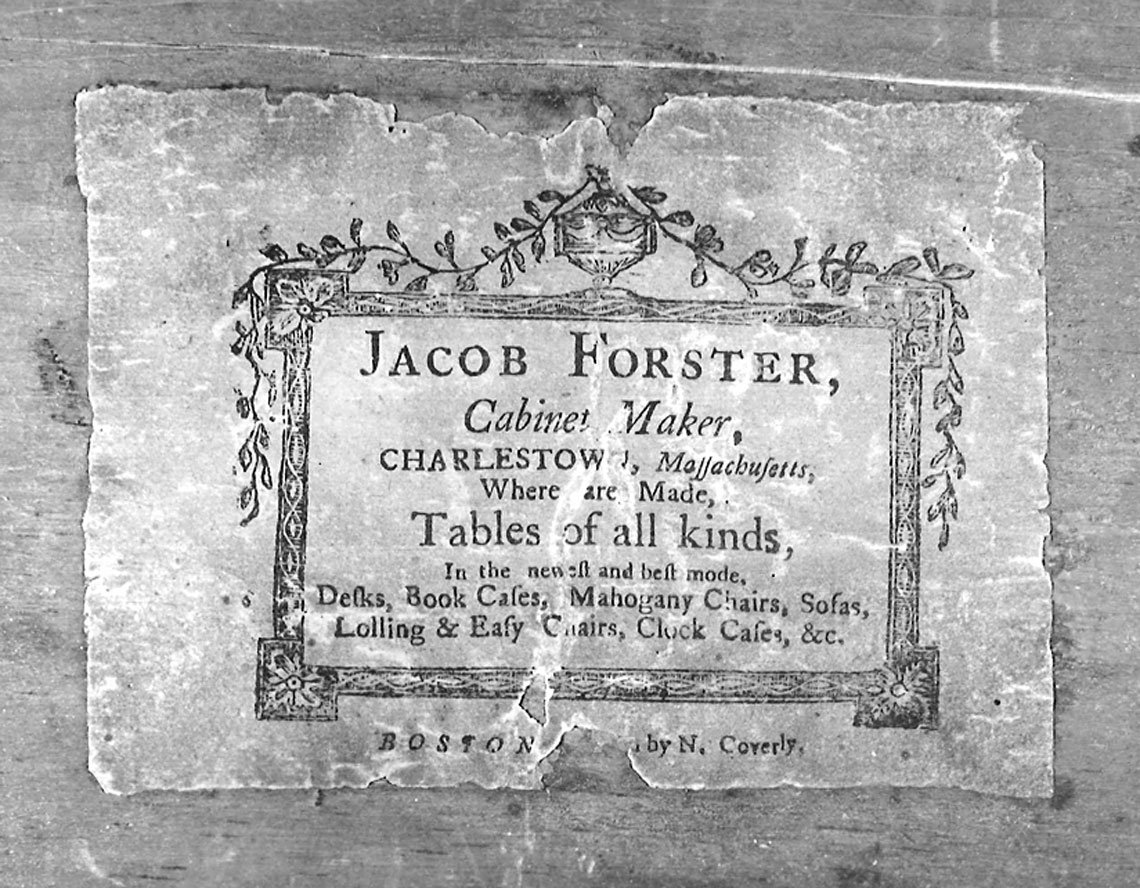 |  | |
| Fig. 3a: Label from figure 3. | Fig. 4: Label of Jacob Forster showing incomplete 179_ date. Courtesy, the Winterthur Library, Decorative Arts Photographic Collection. The four-drawer chest bearing this label is illustrated in “Collectors’ Notes,” ed. Edith Gaines, Antiques 89, no. 6 (June 1966): 841. |
Although the oxbow drawer shape is visually distinctive, period references to the design feature not only lack specificity, they are ambiguous. Estate inventories seldom provide any detail beyond naming the basic furniture form and wood. The 1792 Hartford Cabinetmakers’ Price List referred to “plain” bureaus as well as those “with swell’d front,” an entry that encompassed serpentine and bowed fronts in addition to oxbow.2 Bills of sale were also usually cryptic, as illustrated by records that accompany two oxbow desks. On August 6, 1789, Boston cabinetmaker William Alexander billed “Capt. Shattuck” £7.10s. for making “a swell frunt mahogany desk.” 3 Alexander was recorded from 1780 to 1792 in The Taking books of the Town of Boston, a detailed tax listing of residents that covered the years 1780 to 1799.4 The same terminology appeared on an August 29, 1795 bill from cabinetmaker Abner Toppan (1764-1836) of Newburyport, Massachusetts, when he sold William Little (1763–1795), also of Newburyport, “One mahogany swell front Desk, £10.10s.”5
The dates of these two sales lie well outside the 1760–1780 time period typically assigned to oxbow furniture. Occasional maker’s labels or inscriptions provide additional evidence of when this particular form was made. The chest of drawers in figure 1, for example, is inscribed “Made by John Chipman, Salem, 1794.” Chipman (1746–1819) signed several case pieces and, based on these examples, was the likely maker of several others. In a study of Chipman’s work, Peter A. Louis and Donald R. Sack assigned the earliest possible dates of Chipman’s furniture by dating undocumented but attributed examples from 1775 to 1795.6 Antiques dealer Albert Sack subsequently attributed a pair of chests to Chipman and dated them 1760 to 1785, pushing the range toward its more desirable target within the conventional Chippendale style period.7 Twenty-five-year date ranges may reflect the durability of certain furniture designs, but not necessarily the oxbow form. Moreover, it ignores Chipman’s biographical evidence: he was 16 in 1760. The earliest reference to him as a practicing craftsman, according to Louis and Sack, was in 1776, when he re-stocked a gun.
 |
| Fig. 5: Chest of drawers by Amos Bradley, East Haven, Conn., 1788. Courtesy of the New Haven Museum (2002.6). |
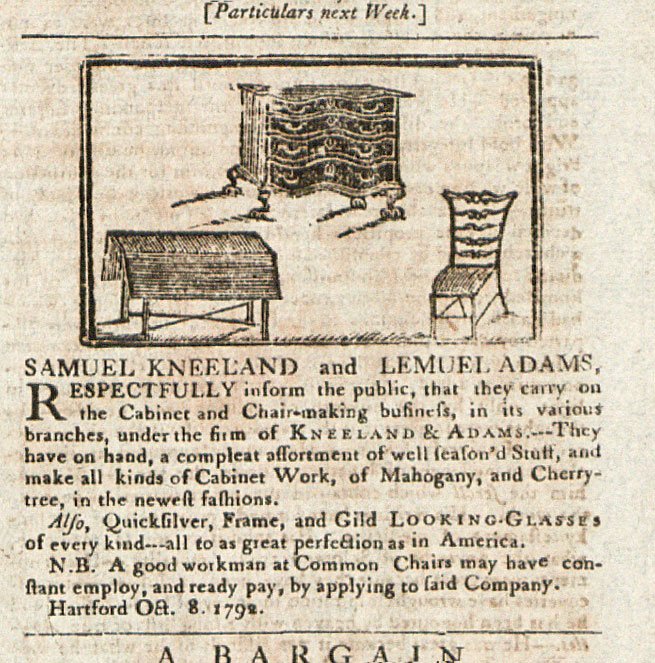 | |
| Fig. 6: Advertisement of Samuel Kneeland and Lemuel Adams, Connecticut (Hartford) Courant, Vol. XXVIII, no. 1446, October 8, 1792: 3. Courtesy of the Connecticut Historical Society. |
Albert Sack’s penchant for early dating affected his influential 1950 book, Fine Points of Furniture: Early American. He illustrated an oxbow slant-lid desk labeled by Samuel Stone and Giles Alexander (son of the aforementioned William) of Boston and assigned it a date range of 1760 to 1780.8 The label does not bear a date but the desk is still datable in part through the maker’s birth and death dates and other retrievable biographical details, including those of label printer Nathaniel Coverly (1744–1816). Listings of the partnership between Stone and Alexander, which lasted from about 1792 until 1796, suggest a later date range than that offered by Sack as well as for a second, nearly identical oxbow desk with a different Stone and Alexander label (Fig. 2).9
Early dates for oxbow case furniture published over the last thirty years would be humorous—if they weren’t so plentiful and misleading. Oxbow chests of drawers labeled by Jacob Forster of Charlestown, Massachusetts, have been dated to “circa 1770” or even 1760–1780 (Figs. 3, 3a).10 Forster was born in 1764 (died in 1838) and would have been a child, or not yet born, when he supposedly made them. In fact, several pieces of his furniture bear printed labels that incorporate the text “179,” the last digit to be filled in with the appropriate year (Fig. 4).11 Biographical evidence suggests that Forster likely ordered these labels in 1793 or later, after he bought land and established his shop in Charlestown.
Although the Boston and North Shore furniture-making communities have long been considered regional style leaders and innovators, references to oxbow furniture made elsewhere in New England reinforces the 1790s date range for the form regardless of where it was made. Amos Bradley (1768–1835) of East Haven, Connecticut, signed a chest of drawers in 1788 (Fig. 5).12 Several examples from the Connecticut River Valley bear dates of manufacture, including a desk and bookcase by cabinetmaker George Belden (1770–1838), then of Hartford, who inscribed his name and place of work, along with the date May 6, 1791.13 Similarly, a 1792 advertisement by the Hartford furniture-making firm of Samuel Kneeland and Lemuel Adams illustrates an oxbow chest (Fig. 6). Oliver Deming (1774–1825) of Wethersfield signed an oxbow chest of drawers he made on July 17, 1796.14 Daniel Clay (1770–1848) of Greenfield, Massachusetts, to the north, signed another chest, now at Historic Deerfield, in 1794. (See Appendix for a list of dated or datable oxbow furniture.)
Chronologically Dated or Datable Oxbow Furniture | ||
| 1780 (February 26); (Figs. 7, 8): Dated chest-on-chest, Nathan Bowen (1752–1837) and Ebenezer Martin (1750–1800), Marblehead, Mass. Richard H. Randall, Jr., American Furniture in the Museum of Fine Arts, Boston (Boston, Mass.: Museum of Fine Arts, 1965), cat. no. 41. 1780 (September 19): Dated slant-lid desk, Nathan Bowen, Marblehead, Mass. Christie’s Fine American Furniture, Silver, Folk Art and Decorative Arts auction (New York, October 19, 1985), lot 200. 1788; (Fig. 5): Signed and dated four-drawer chest, Amos Bradley (1768–1835), East Haven, Conn. Thomas P. Kugelman and Alice K. Kugelman with Robert Lionetti, Connecticut Valley Furniture: Eliphalet Chapin and His Contemporaries, 1750–1800 (Hartford: Connecticut Historical Society, 2005), cat. no. 185. 1789: Labeled and dated slant-lid desk, “EM 1789,” (possibly Ebenezer Martin, Marblehead, Mass.). Sotheby’s, Important American Furniture, Folk Art, Folk Paintings, and Silver auction (New York, October 24, 1987), lot 470. 1789 (August 6): Bill to Capt. Shattuck for slant-lid desk, William Alexander, Boston, Mass. In N. I. Bienenstock, A History of American Furniture (N. P. 1936; reprint 1970), 8. 1789 (circa): Secretary bookcase, Eliphalet Chapin shop. In Kugelman, et al., Connecticut Valley Furniture, cat. no. 67. The date represents the period when three separate signers on the secretary bookcase worked concurrently in Chapin’s shop. The great height of the secretary bookcase and other circumstances suggest it was made for the twelve-foot ceilings of a house completed in 1789 for John Watson of East Windsor. 1790 or later: Four-drawer chest, Calvin Willey (1769-after 1831), Lenox, Mass. Kugelman, et al., Connecticut Valley Furniture, cat. no. 108. Given Willey’s age, this chest likely was made no earlier than 1790. Its provenance suggests original ownership by Hannah Howell and Nathan Peirson, who bought furniture for their new house in Richmond, Mass., completed in 1790. 1791: Inscribed and dated four-drawer chest labeled “EM 1791” (probably Ebenezer Martin, Marblehead, Mass.). In Brock Jobe and Myrna Kaye, New England Furniture: The Colonial Era (Boston, Mass.: Houghton Mifflin, 1984), fig. I-31. 1791 (May 6): Desk and bookcase, signed and dated by George Belden (1770–1838), Hartford, Conn., Wadsworth Atheneum (1980.64). 1791–1793: Four-drawer chest, George Belden (1770–1838), Hartford, Conn. In Kugelman, et al., Connecticut Valley Furniture, cat. no. 164. Belden signed this chest with “Hartford,” where he worked before moving to Windsor in 1793. The 1791 date is when he reached adulthood. 1792–1796: Labeled slant-lid desk, Samuel Stone and Giles Alexander, Boston, Mass. In Albert Sack, Fine Points of Furniture: Early American (New York: Crown, 1950), 147. The date range reflects the period of their partnership. 1792–1796: (Fig. 2): Labeled but undated slant-lid desk, Samuel Stone and Giles Alexander, Boston, Mass. In Bernard and S. Dean Levy, Inc., Vol. VI (New York, 1988), 93. The date range reflects the period of their partnership. 1793 or later: Built-in chest-on-chest and desk and bookcase, William Flagg (1772–1858), East Windsor, Conn. In Kugelman, et al., Connecticut Valley Furniture, cat. nos. 68, 69. Because evidence of apprentice signatures on furniture is almost entirely lacking, William Flagg’s signature on the desk and bookcase and initials on the chest-on-chest suggest the dating, which is after he turned 21. 1793 or later; (Fig. 3): Labeled but undated four-drawer chest, Jacob Forster (1764–1838), Charlestown, Mass. In Israel Sack, Inc., Opportunities in American Antiques, Vol. 7, 1934–35 (Israel Sack, Inc., 1963), P5290. Forster did not establish his shop in Charlestown before 1793, making that the earliest possible date for his labeled furniture. | 1793 or later: Labeled but undated Four-drawer chest, Jacob Forster (1764–1838), Charlestown, Mass. In “Pedigreed Antiques: XV. Serpentine Chest and Tabernacle Mirror,” Antiques 7, no. 6 (June 1925): 316-317. See previous entry for dating. 1793 or later: Three-drawer chest, George Belden (1770–1838), Windsor, Conn. In Kugelman, et al., Connecticut Valley Furniture, cat. no. 165. Belden added the place name “Windsor” to his signature. Because he moved there from Hartford in 1793, that date becomes the earliest date for this chest. 1794 (October 17): Desk and bookcase, Massachusetts. The Metropolitan Museum of Art (53.179.1a). The date only is inscribed; no maker identification. 1794; (Fig. 1): Four-drawer chest, inscribed “John Chipman, Salem, 1794,” John Chipman (1746–1819), Salem, Mass. In Peter A. Louis and Donald R. Sack, “John Chipman, Cabinetmaker of Salem, Massachusetts.” Antiques 132, no. 6 (December 1987):1321, fig. 6. 1794 (November 4 printed on label): Labeled four-drawer chest, Daniel Clay (1770–1848), Greenfield, Mass. Historic Deerfield (76.12). 1794 (December): Four-drawer chest, Wethersfield, Conn, area. In Kugelman, et al., Connecticut Valley Furniture, cat. no. 175A. This chest, whereabouts unknown, bears the inscription “December 1794.” 1795: Three-drawer chest, Bates How (b. 1776), Northwestern Conn., Yale (1930.2154). 1795 (August 25): Slant-lid desk, Abner Toppan (1764–1836), Newburyport, Mass. In Dexter Edwin Spalding, “Abner Toppan, Cabinetmaker.” Antiques 15, no. 6 (June 1929): 493–494; American Art Association, Anderson Galleries, American Antiques: Collection of Israel Sack (New York, November 7-9, 1929), lot 270. 1795: Desk and bookcase Abner Toppan (1764–1836), Newburyport, Mass. In Jobe and Kaye, New England Furniture, fig. I-32. The desk and bookcase is documented by a dated bill of sale, now lost. 1795: Bill for chest-on-chest, Abner Toppan (1764–1836), Newburyport, Mass. In Mabel M. Swan, “Newburyport Furnituremakers,” Antiques 47, no. 4 (April 1945): 224. The chest-on-chest is documented by the same bill of sale as the Toppan desk and bookcase. 1795 or later: Signed desk and bookcase, Erastus Grant (1774–1865), Westfield, Mass. In Kugelman, et al., Connecticut Valley Furniture, cat. no. 183.The earliest date for this desk and bookcase derives from the maker’s age. 1795 or later: Labeled four-drawer chest, Pelatiah Bliss (1770–1826), Springfield, Mass. In “Collectors’ Notes.” Antiques 148, no. 1 (July 1955): 62. The maker set up his shop in Springfield in 1795. 1795 or later: Four-drawer chest, Oliver Deming (1774–1825), Wethersfield, Conn. In Kugelman, et al., Connecticut Valley Furniture, cat. no. 175. Dating of this chest derives from when its maker turned 21. 1796 (July 17): Signed and dated four-drawer chest, Oliver Deming (1774–1825), Wethersfield, Conn. In Jarius B. Barnes and Moselle Taylor Meals, American Furniture in the Western Reserve, 1680–1830 (Cleveland, Ohio: Western Reserve Historical Society, 1972), 55. 1799 (June 5): Desk and bookcase, Gilmanton, N.H. Currier Museum of Art (1958.6). 1799: Desk and bookcase, Massachusetts or New Hampshire. In M. Ada Young, “Five Secretaries and the Cogswells.” Antiques 88, no. 4 (October 1965): 482–483, figs. 5, 5A–5C. No maker, just the date. | |
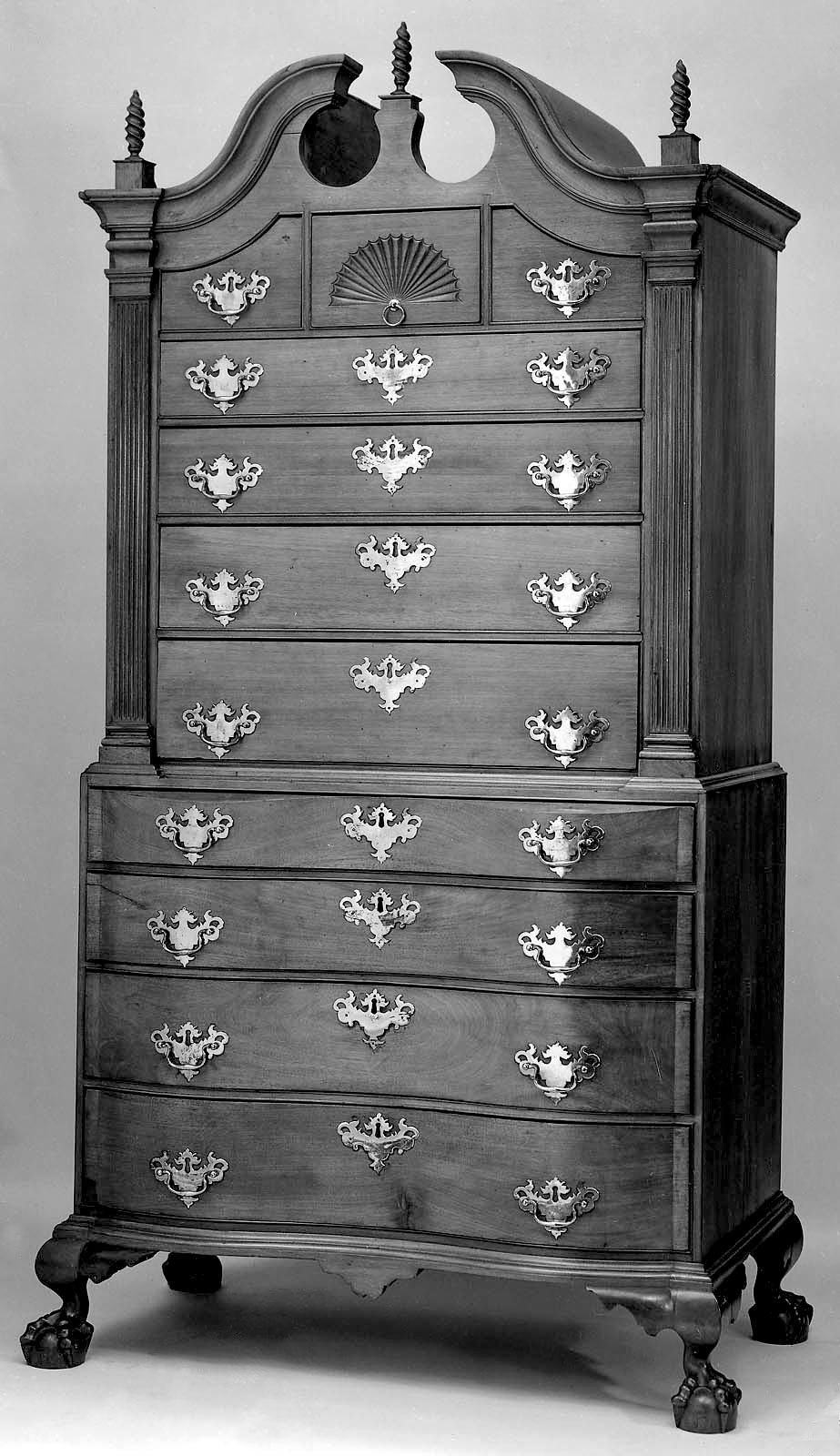 | |
| Fig. 7: Chest-on-chest, Nathan Bowen (1752-1837) and Ebenezer Martin, Sr. (1750-1800), Marblehead, Mass., 1780. Mahogany and white pine. H. 84-3⁄16, W. 42, D. 24-1/2 in. Courtesy of the Museum of Fine Arts, Boston; Gift of Miss Josie F. Prescott and Miss Mary E. Prescott (33.373). |
A few examples of oxbow furniture were probably made after 1800, such as a birch desk and bookcase at the Currier Museum of Art with a post–1800-style mahogany veneered frieze.15 However, the dated examples cluster from 1788 to about 1800; others are associated within this range by family histories, which note marriage dates.16 Such date evidence is unproven, but endorses the general argument.
Given the post-1788 dating, an oxbow chest-on-chest signed by Nathan Bowen (1752–1837) and Ebenezer Martin (1750–1800) of Marblehead, Massachusetts, and dated February 26, 1780, is surprising (Figs. 7, 8), though the inscription appears genuine.17 A second oxbow form—a slant-lid desk—also bears Bowen’s name and the date September 19, 1780 (or 1786—the earlier date is widely reported but the last integer is not clear from an examination in 1999).18 These two case pieces are the earliest documented examples of oxbow furniture in America (or anywhere else) by several years. However, Bowen billed Martin for making both “a Desk Swelld Front” and a “Swelld Case Drawers” in 1777, and a “Swelld Desk” the following year.19 These case pieces may have been oxbow forms, although ambiguous terminology must be acknowledged and could refer to cases with serpentine facades, or other shapes, perhaps even blockfronts.
Understanding the timing of Bowen’s innovative work and the interval before the onset of the dozens of signed examples after 1788 is a challenge. The hiatus may stem from post-Revolutionary War conditions, including debilitating indebtedness and maritime trade prohibitions that must have deeply affected Marblehead and the rest of New England. But general circumstances seldom explain the particular, which in this instance simply lacks enlightening evidence. What is true, however, is that no clear evidence of oxbow furniture exists outside of Marblehead before the 1788 chest from East Haven, Connecticut, seen in figure 5.
The historical evidence that corrects the dating of oxbow furniture to the period of about 1788 to 1800 is compelling. As noted, the present consensus for earlier dating derives from two strong influences. First, the marketplace heavily favors earlier dates and dating. Second, cumulative opinions, especially those in print, provide widespread, although still unfounded, support for the early date ranges. Relatively recently, for instance, an auction catalogue assigned an eye-catching date range beginning in 1750 for an oxbow chest.20
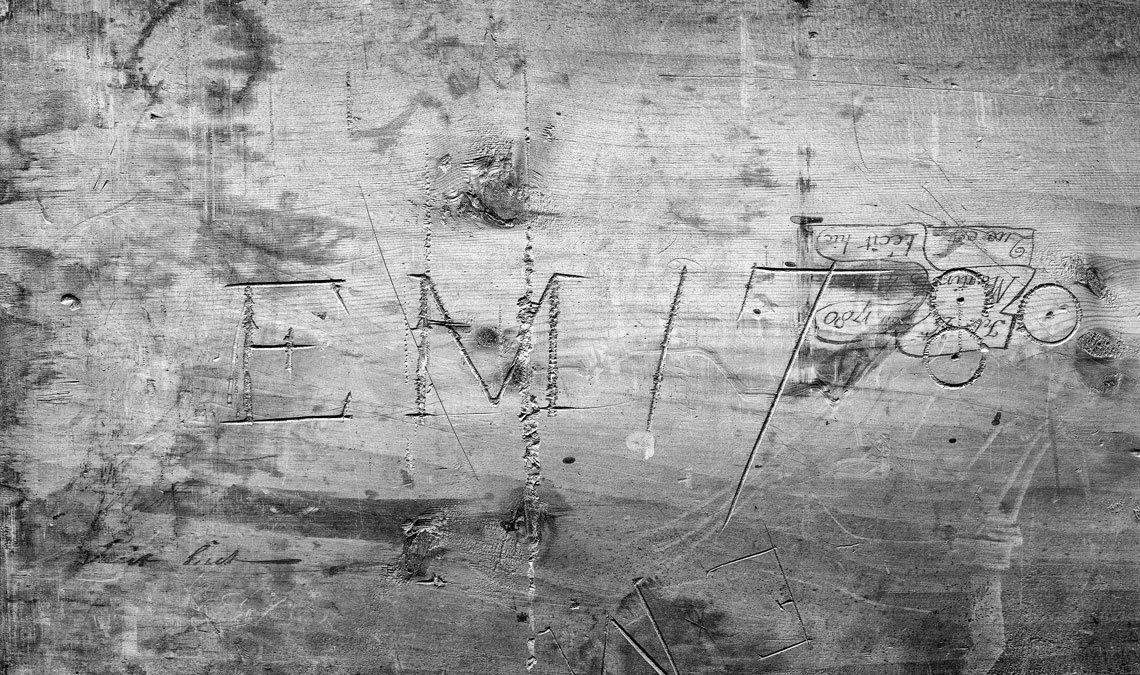 |
| Fig. 8: Inscription on the chest-on-chest in figure 7. |
Misalignment of this consensus-based dating with actual historical circumstances generates two problems for the furniture historian. First, it is wrong, in light of ample evidence. Second, the time shift removes the furniture in question from its true chronological and historical context. This furniture, which embodies significant Chippendale style attributes, was stylish in the 1790s, beyond the generally accepted start of the Federal period. Its manufacture by leading furniture makers in several New England style centers argues that furniture historians need to be more flexible in style-based dating of this particular form, and of Chippendale furniture more generally. The many examples of oxbow furniture documented from 1788 onward (28 of 30 listed in the Appendix) provides compelling evidence that, in the absence of specific contrary evidence, the undated pieces of furniture with oxbow facades were also made between 1788 and 1800, or even later.
Philip D. Zimmerman is a museum and decorative arts consultant based in Lancaster, Pennsylvania.
This article was originally published in the Autumn 2017 issue of Antiques & Fine Art magazine, a fully digitized edition of which is available at www.afamag.com.AFA is affiliated with Incollect. The magazine title for this article was "Dating Oxbow Furniture."
2. Reprinted in The Great River: Art and Society of the Connecticut Valley, 1635–1850 (Hartford, Conn.: Wadsworth Atheneum, 1985), 472.
3. N. I. Bienenstock, A History of American Furniture (1936; reprt. ed., East Stroudsburg, PA: Towse Publishing, 1970), 8. Capt. Shattuck might have been Job Shattuck (1736–1819) of Groton, Massachusetts, who served in the American Revolution and was commissioned a captain in 1776. He was famous for his activities during Shay’s Rebellion, which earned him a death sentence, commuted by Gov. John Hancock in September 1787.
4. Anne Rogers Haley, “Boston Cabinetmakers and Allied Craftsmen, 1780-1799: A New Source,” Antiques 149, no. 5 (May 1996): 762.
5. Dexter Edwin Spalding, “Abner Toppan, Cabinetmaker.” Antiques 15, no. 6 (June 1929): 493–494.
6. Peter A. Louis and Donald R. Sack, “John Chipman, Cabinetmaker of Salem, Massachusetts,” Antiques 132, no. 6 (December 1987): 1321, fig. 6.
7. Albert Sack, The New Fine Points of Furniture: Early American–Good, Better, Best, Superior, Masterpiece (New York: Crown, 1993), 104. Sack dated all other oxbow pieces of furniture from 1760 to 1780; see pp. 102–104.
8. Sack dated this desk and all of the illustrated oxbows from 1750-1780. The desk had been correctly dated in Mabel M. Swan, “Boston’s Carvers and Joiners, Part II: Post-Revolutionary.” Antiques 53, no. 4 (April 1948): 282, fig. 3.
9. Bernard & S. Dean Levy, Inc., Volume VI (January 1988), 93.
10. Sotheby’s, Selections from Israel Sack, Inc. (New York, January 20, 2002), lot 1198; Sotheby’s, Important Americana, (New York, January 21–22, 2011), lot 266.
11. “Pedigreed Antiques: XV. Serpentine Chest and Tabernacle Mirror,” Antiques 7, no. 6 (June 1925): 316–317.
12. Illustrated in Thomas P. Kugelman and Alice K. Kugelman with Robert Lionetti, Connecticut Valley Furniture: Eliphalet Chapin and His Contemporaries, 1750–1800 (Hartford: Connecticut Historical Society, 2005), cat. no. 185.
13. Kugelman, et al., cat. no. 167.
14. Sotheby’s, Important Americana (New York, January 2013), lot 315.
15. At the time of this research, no dated or datable oxbow furniture after 1800 has come to light, making 1800 a convenient end-date for this study. The point of this essay is that oxbows have been dated too early, not too late.
16. Such information is used to identify John Smith (1768–1834), Barre, Mass., as the ca. 1793 maker of a cherry oxbow chest of drawers (Old Sturbridge Village, acc. no. 5.38.28).
17. Richard H. Randall, Jr., American Furniture in the Museum of Fine Arts, Boston (Boston, Mass.: Museum of Fine Arts, 1965), cat. no. 41.
18. Christie’s, Fine American Furniture, Silver, Folk Art and Decorative Arts (New York, October 19, 1985), lot 200; Sack, New Fine Points, 160; Sotheby’s, Important Americana: Furniture and Folk Art (New York, January 16–17, 1999) lot 787.
19. Nathan Bowen, account book, 1775–1779, Winterthur, Downs Manuscript and Microfilm Collection, 1079.
20. Christie’s, Important American Furniture, Folk Art & Decorative Arts (New York, January 24, 2014), lot 138.




















